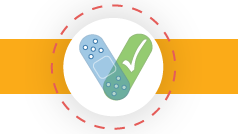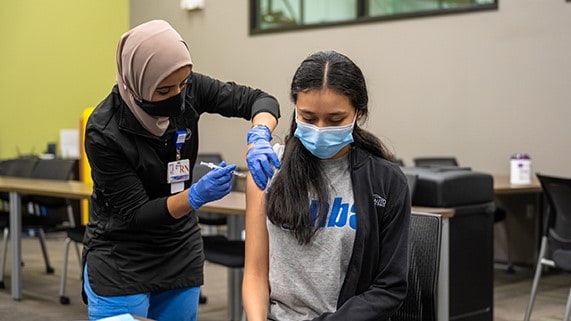Key points
- Vaccines have saved lives for more than 100 years, but serious disease is still a threat.
- Vaccination coverage for COVID-19, flu, and other routinely recommended adult vaccines in the United States remains low.
- State and local organizations can increase awareness, confidence, demand, and access for adult vaccines.

Background
Vaccines have greatly reduced diseases that once routinely harmed or killed babies, children, and adults. People all over the world—including in the United States—still become seriously ill or even die from diseases that vaccines can help prevent.
US vaccination coverage for COVID-19, flu, and other routinely recommended adult vaccines remains low. Adult vaccine coverage is lower in racial and ethnic minority groups than among White populations.
Many factors create challenges to vaccination access, and acceptance. These factors include job access and working conditions, gaps in health care access, and mistrust in medical systems.

CDC's Partnering for Vaccine Equity (P4VE) program improves vaccine equity across disproportionately affected populations. Vaccine equity is when everyone, regardless of socioeconomic status, race, ethnicity, geographic location, or other determinants of health, has a fair and just opportunity to be vaccinated. The program provides funding and support to national, state, local, and community partners. Partners address vaccine equity in both children and adults and across multiple priority populations.
As part of a 2023 funding announcement, REACH recipients could apply for supplemental funds to implement P4VE strategies. REACH is CDC's Racial and Ethnic Approaches to Community Health program. This strategy aims to increase awareness, confidence, demand, and access for flu, COVID-19, and other routinely recommended adult vaccines.
Potential Activities
.
Tip
In the activities on this page:
* Indicates short-term activities which can generally be accomplished in 1 to 2 years.
+ Indicates long-term activities which may take up to 5 years, depending on organizational capacity, previous work in this area, and project size.
Detail barriers to vaccine uptake, addressing specific disparities, drivers of vaccine hesitancy, and successful strategies for improving vaccine uptake.
Work with communities to identify and address drivers of vaccine hesitancy, identify influential community messengers and partners, and develop community-acceptable approaches for improving vaccination availability, accessibility, and confidence.*
Conduct needs assessment using methods such as questionnaires, interviews, town halls, and focus groups with community members affected by inequities.*
Document insights, common challenges, and key lessons learned, based on community interactions and learnings. Share insights of others working to increase vaccine coverage.*
Educate and empower trusted voices in the community to support vaccine education and delivery.*
Develop and/or tailor audience-tested materials and messages. “Audience tested” includes community-based, culturally and linguistically appropriate messages that focus on the following:
- Disease spread, symptoms, prevention, and treatment.*
- Vaccine safety and efficacy.*
- Vaccination purpose, need, and opportunities/locations.*
Identify and train trusted community spokespersons to communicate disparities in COVID-19, flu, and recommended routine adult vaccinations, as well as the importance of vaccination. Community spokespersons could be faith leaders, teachers, community health workers, radio DJs, local shop owners, and barbers. Communication channels might include news media, advertising, social/digital media, partner media, faith-based venues, community events, and other community-based, culturally appropriate venues.*
Build partnerships with health care providers to increase understanding of:
- Communities affected by inequities in access to vaccines and those with low vaccination coverage.*
- Interventions to increase vaccination rates for these groups.*
- The importance of health equity; refer to the Community-Clinical Linkages (CCL) Health Equity Guide.
Build partnerships between vaccination providers and the community to make more opportunities for priority groups to get vaccinated.+
Work with vaccination service providers to expand the types of health professionals and administrative staff engaged in: promoting COVID-19, flu, and recommended routine adult vaccinations; and increasing referrals of individuals to vaccination sites. Health professionals could include community health workers, patient navigators, and patient advocates. Administrative staff could include front desk workers.+
Guide information exchange between community partners and CDC.+
Conduct ongoing evaluation to identify priority needs and the actions needed to meet those needs. Ongoing evaluation will measure impact of other activities including conducting needs assessments; equipping essential messengers; and increasing vaccination opportunities. Evaluation can also document improvement in the health status of the community served.+
Create a yearly evaluation plan to describe the overall evaluation approach. Key elements of the plan include reasons to conduct the evaluation, intended use for findings, proposed design, and data collection methods and sources.+
An evaluation plan should: detail process and outcome measures, address how activities help increase vaccination and access to vaccine services; and clarify how to decrease disparities and reduce disease rates among the priority audience.+
Monitoring may also include:
- Ensuring that work plans are feasible based on the budget and are consistent with the intent of the program.+
- Ensuring performance is at a sufficient level to achieve outcomes within stated timeframes.+
- Adjusting the work plan based on achievement of outcomes, evaluation results, and changing budgets.+
- Monitoring performance measures (both programmatic and financial) to assure satisfactory performance levels.+
- Completing quarterly reports.+
- Submitting monthly progress reports and monitoring calls.+
Working together
Fairfax, Virginia
Fairfax County officials engaged community organizations and churches to help provide transportation for community members to vaccination sites.
Albany County, New York
Albany County worked in a state-approved partnership with Mohawk Ambulance Service to increase COVID-19 vaccine access to homebound seniors. From 2021 to 2022, Mohawk Ambulance's mobile vaccination trailer held up to 8,000 vaccine doses at a time, and the company hired an additional 50 staff with another 25–50 on standby to help with the effort.
District of Columbia
The District of Columbia Health Department and local business districts partnered to offer free COVID-19 testing and COVID-19 vaccinations. The pop-up site was available to hotel staff, restaurant workers, building engineers, and other essential workers. The testing vaccination sites were open during nontraditional business hours.
Southern Nevada Health District
Southern Nevada Health District developed a multi-component media campaign in English and Spanish. The district implemented mass vaccination events and developed vaccination teams in their respective communities to increase vaccine access. Activities focused on groups at higher risk of both influenza and COVID-19. These groups included:
- Staff and residents of long-term care facilities.
- Adults with underlying illnesses.
- People who are African American or Latino.
- Essential workers.
Albuquerque, New Mexico
Presbyterian Healthcare Services used population demographics and health outcomes data to inform their program planning. They specifically focused on geographic areas needing more outreach, communication, and vaccination drives.
Resources
Partnering for Vaccine Equity Program
CDC program to equitably improve vaccine access, confidence, and demand through funded partnerships.
Vaccine Resource Hub
Hundreds of materials to support vaccination. Also includes planning roadmaps, funding opportunities, and success stories.
Vaccines in the Adult Immunization Schedule
Vaccines recommended for adults, including their abbreviation, and trade name(s).
Cross-cutting areas
Communication tips to support program efforts.
Evaluation framework for making evaluations useful, feasible, ethical, accurate, and culturally responsive.
Health equity tools to help remove barriers to health.
Definitions
Immunization is the process by which a person becomes protected against a disease through vaccination. This term is often used interchangeably with vaccination or inoculation.
Routine vaccines are those recommended for US adults, depending on age and vaccine history.
Vaccination is introducing a vaccine into the body to produce protection from a specific disease.
Vaccine confidence is the belief that vaccines work, are safe, and are part of a trustworthy medical system.
Additional priority strategies
Breastfeeding Continuity of Care
Early Care and Education (ECE) Policies and Activities
Family Healthy Weight Programs
Food Service and Nutrition Guidelines
Increasing Physical Activity Through Community Design
